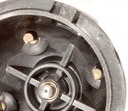Modern British car ignition choices are fraught with danger. Originally, we had contact point breakers, solid wires and non-resistor plugs, and it was good enough. Then we got radios and found that our ignitions were broadcasting so much noise that we couldn't hear Charley McArthy over the buzzing. So, now we have resistor plugs, resistor wires, electronically triggered distributors and off-shore manufactured replacement parts, and any combination of them put together. Lets go over a few things, shall we?
Points are just fine. Unless you are racing at high RPMs, points will work. Periodically, they will need to be cleaned, adjusted or replaced. Condensers can fail and burn up the contacts. There are more connections in the system and more ways to put things together so that they don't work. But installed properly and maintained, points are fine.
If you would like to get rid of points, you can install a Pertronix Ignitor, which is self-contained electronic trigger kit to fire the coil. The points and condenser are replaced by a small plastic ring with embedded magnets that fits over the cam and an electronic pickup/trigger that senses the rotating magnets and fires the coil. Easy two-wire installation, and it is easily reverted back to points should you ever want to. I installed many, many Pertronix kits and only a few failures over the years.
Another popular option is the Crane XR700 Optical kit. Instead of a flying magnet, the Crane uses a shutter wheel and an optical sensor. It also has an external amplifier box, which powers the pickup and does the coil switching, so it is a more visible modification. They are very reliable, and have a lifetime warranty. The drawback is that, unlike the Pertronix, which is an almost drop-in installation, the Crane kit has a sort of "erector set" installation, and one must follow directions carefully to get all the little bits in the right place. So, excellent reliability, bit of a hassle to install.
Caps: buy the good ones with the brass contacts. Cheaper caps with aluminum contacts will erode quicker.
Rotors: There are a lot of bad rotors out there. Not as many as there were a few years ago, but enough that I will not bother to use a black rotor. A great many were made "overseas" shall we say, and the black plastic has too high a carbon content. They go conductive and your ignition goes away. Only use the newer red-colored rotors. They are great and won't suddenly decide that you don't get ignition any more.
Wires and Plugs: In order of preference, I like NGK, Nippon-Denso, and Autolite. Bosch quality has been variable, and Champion is the bargain basement. I understand they they re-tooled a couple of years ago, but I am not ready to risk a broken plug to save a dollar. Projected nose plugs are good, split-contact is a gimmick and platinum costs too much and doesn't make financial sense in our older setups.
Having some resistance is good. Either use resistive plugs or resistive wires, but not both. You are shooting for 1-2K Ohms total resistance per path, including the coil wire, rotor, secondary wires and the plugs. Too much resistance will cause the spark to find a shorter route to ground. See the images for what happens with resistive plugs and resistive wires in a 25D cap.
Side entry caps were designed for solid wires. Don't use solid wires with an electronic trigger! The RF noise will freak out the module and cause erratic behavior. If you HAVE to have an original cap or solid wires for show purposes, make up a set of "driving" cap and wires, with a top-enrty cap and resistive wire, then swap out the components at the show. If you really need a side-entry cap, I can make up a custom set of resistive wires that will work in there, but you will have to cut the points off of the contact screws so that they will not pierce the wires.



